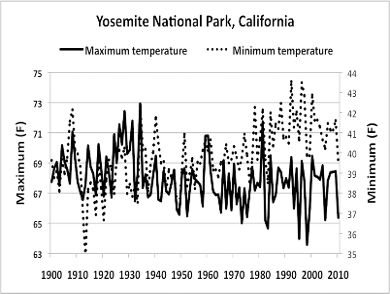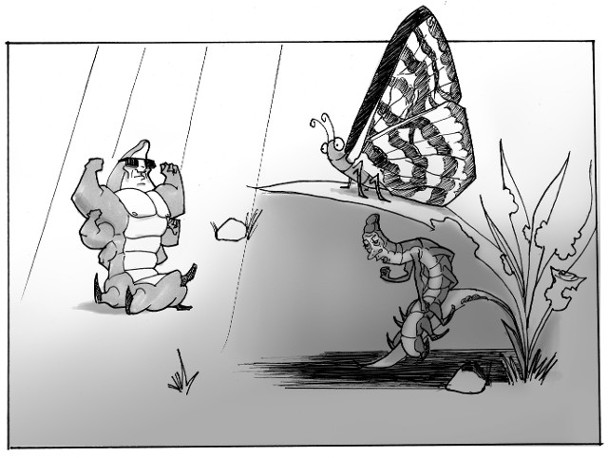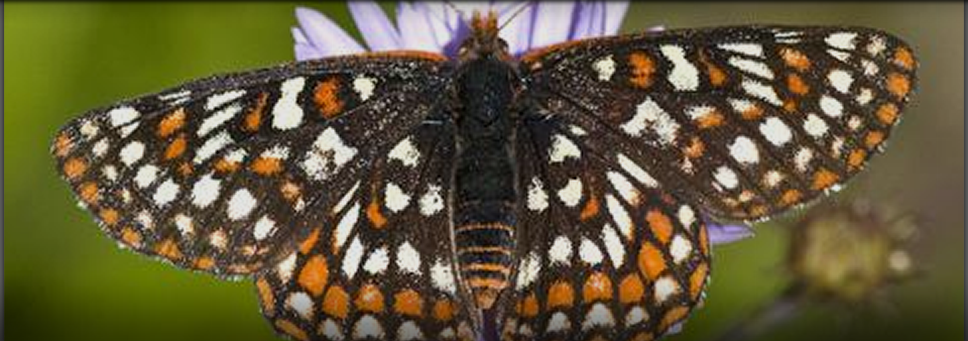Fabricating Climate Doom: Parmesan’s Butterfly Effect
The pioneers of chaos theory coined the term “butterfly effect” to suggest that a hurricane's formation could be affected by such unpredictable influences as the flap of a distant butterfly’s wings that changed the winds’ direction weeks before. Ironically, it was Dr. Camille Parmesan’s 1996 seminal Edith’s checkerspot butterfly paper titled " Climate and Species Range"1 that became the model for future peer-reviewed papers that blamed climate change for driving species northward and upward and causing species extinctions. Featured on the Union of Concerned Scientists' website, Parmesan echoed Dr. Jim Hansen's catastrophic predictions that global warming was already forcing global ecological collapse, "The latest research shows clearly that we face the threat of mass extinctions in coming years," she says. "My hope is that we will be able to reduce emissions enough so that assisted colonization efforts can be successful, because at the higher ranges of scientists' projections of warming trends, frankly, we're sunk." For promoting global warming theory, she subsequently earned an invitation to speak at the White House and became one of just four biologists to partake in third global climate assessment by the United Nations' Nobel-Prize-winning Intergovernmental Panel on Climate Change (IPCC). By 2009, Parmesan ranked as the second-most cited author of papers devoted expressly to global warming and climate change.2
Einstein said, “A question that sometimes drives me hazy: am I or are the others crazy?” and the fanfare given Parmesan drove me hazy. Detailed studies by butterfly experts and conservationists dedicated to saving the butterfly from extinction had all blamed habitat destruction and sought habitat restoration. In contrast Parmesan blamed global warming and argued for reduced carbon emissions. She had blamed “global” warming even though most maximum temperatures in California had not risen significantly.3 More disconcerting the butterflies never migrated northward or upward, as claimed. Yet she now seeks funding to support an ecologist’s worst nightmare, assisted colonization. Parmesan wants to create her own Noah’s ark shuttling animals northwards and upwards so they can escape the supposed rising tide of warmth predicted by models, despite the fact that introducing species into new habitat brings disease and disrupts the established ecological balance.
To her credit Parmesan had diligently spent four years of extensive and laborious fieldwork revisiting locations where the butterfly had been observed earlier in the century. However after verifying that more populations had gone extinct in the southern extremes and at the lowest elevations of the butterfly's range, Parmesan enthusiastically claimed her results were consistent with global warming theory. In 2010 she summarized her work: "it was a bloody obvious change. These butterflies were shifting their entire range over the past century northward and upward, which is the simplest possible link you could have with warming. I was expecting some incredibly subtle, sophisticated response to warming, if at all. What I got was 80% of the populations in Mexico and the Southern California populations were extinct, even though their habitats still looked perfectly fine."2 But as I discovered later Parmesan always knew the butterflies had never migrated further north or to higher elevations.
Hansen’s global warming theory had predicted that the increasing maximum temperatures would push animals northward and upward, however Parmesan failed to mention that most of California's maximum temperatures had never exceeded the highs of the 1940s as seen in Yosemite National Park. In fact her paper never analyzed local temperatures at all. Parmesan relied on the political global warming bias. Parmesan was speaking globally, but butterflies always act locally. Ask any university ecology professor. They would not hesitate to harshly criticize an undergraduate term paper that used a “global average” to explain a local event; yet that was her only climate “evidence”.

Furthermore Parmesan failed to address the fact that higher temperatures enhanced the butterfly’s survival. Warm microclimates are critical for its survival. Caterpillars living in cooler microclimates develop more slowly, while those actively basking in the direct sunlight digest their food more quickly and grow more robustly. Cool rainy years often extirpated local populations.
Since the 1950s, Stanford University's Paul Ehrlich and his colleagues had made detailed observations throughout the checkerspot’s habitat on the Jasper Ridge Preserve. They determined that the caterpillars must raise their body temperature an additional 18-21°F above ambient air temperatures. To raise their body temperature, caterpillars shuffled across the hillsides seeking life?giving hot spots.4,5,6 Any global warming, natural or anthropogenic, should have been a benefactor, not an executioner.

 Parmesan’s observations of extirpated populations were not new. Conservationists had sounded the extinction alarm years before her “global warming study”. Butterfly populations had diminished so quickly that the checkerspot’s apparent fate was compared to the rapid ruination of the extinct passenger pigeon. Scientists working to prevent extinction had always warned that the suburban sprawl from Los Angeles to San Diego had devoured the butterfly's critical habitat and extirpated most populations.7,8 When the checkerspot’s southern California Quino subspecies was finally listed as endangered, conservation scientists wrote, "The basis for the listing was habitat loss, degradation, and fragmentation, recognizing additional negative effects from fire management practice. All factors are the results of intensive human economic development of ever diminishing resources."60
Parmesan’s observations of extirpated populations were not new. Conservationists had sounded the extinction alarm years before her “global warming study”. Butterfly populations had diminished so quickly that the checkerspot’s apparent fate was compared to the rapid ruination of the extinct passenger pigeon. Scientists working to prevent extinction had always warned that the suburban sprawl from Los Angeles to San Diego had devoured the butterfly's critical habitat and extirpated most populations.7,8 When the checkerspot’s southern California Quino subspecies was finally listed as endangered, conservation scientists wrote, "The basis for the listing was habitat loss, degradation, and fragmentation, recognizing additional negative effects from fire management practice. All factors are the results of intensive human economic development of ever diminishing resources."60
The conservationists’ detailed studies also reported that most extinctions observed in southern California had already transpired by the 1970s, before any purported CO2 warming had significantly developed and furthermore populations were now recovering. In 2003 researchers wrote, "although we now know that the butterfly likely disappeared from Orange County thirty years ago, it was rediscovered in Riverside County in the early 1990s, and in San Diego County at several formerly occupied sites soon after."8
Nor were extinctions limited to the southern end of the butterfly’s range. Rapid urban development entirely extirpated the Canadian subspecies (the Taylor checkerspot) from the coldest northern end of the butterfly’s range. But because there was a greater preponderance of extinctions in southern California, the "average statistical center" for the species migrated northward. There was never any evidence of any real migration due to warming. There was never an apocalyptic flight to cooler lands. Parmesan’s climate claim was solely a statistical fairy tale. Still Parmesan's unscientific climate claim was published in one of the most prestigious scientific journals with one of the highest rejection rates, Nature.
How did Parmesan deal with the multitude of contradictory factors? Instead of a more detailed study, she simply argued, "the predicted effects of climate change will come, not from attempts to analyze all possible confounding variables in single studies such as this one, but from replication of this type of study."1 In essence, by arguing that confounding factors were no longer important, she suggested we throw out the foundation of good scientific analysis. To demonstrate the negative impacts of climate change, all anyone needed to do was demonstrate that populations were dwindling in the south more than in the north, or dwindling more at lower elevations than at higher elevations. Implausibly, the prestigious journal Nature supported this “new climate science.”
Defying the Experts
The evidence against any CO2 connection was overwhelming, but I was no butterfly expert. Needing a reality check, I talked with my friend Dr. Paul Opler, one of North America's top butterfly experts. If you have ever spent any time with Paul, you quickly realize that no one has a greater love for butterflies. If there was the smallest threat, he would be the first to speak out. In 1974, he was hired as the first invertebrate specialist for the United States Federal Endangered Species program. Virtually every butterfly species now listed as endangered was listed under his watch. To my great good fortune, he agreed to teach a course, "Butterflies of the Sierra Nevada" (which he still teaches), for my environmental education program each year. When he visited, I expressed my doubts about the legitimacy of Parmesan's claims and my bewilderment at all the media hype, and I asked if he had seen any supporting evidence.
He carefully stated that from all the data he had perused, he had seen absolutely no evidence that any butterflies had ever moved northwards, nor had they been pushed to higher elevations. He added the checkerspot has now been discovered further south in Baja, Mexico. He too couldn't understand the public fanfare and echoed my thoughts that “only her statistical averages moved, not the butterflies". Due to his expertise, Opler had been invited by the Fish and Wildlife Service to comment on the proposed recovery plans for the subspecies in southern California and wrote:
The lengthy space given to Camille Parmesan's study and the suggestion that newly found colonies are the result of global warming is highly speculative. Her study did not find new northern, or higher populations of the species. Her results were a statistical artifact of the purported loss of low-lying southern populations (emphasis added). Her surveys that showed the absence of butterflies in some population areas could have been carried out in relatively bad years when the species was present only as diapausing larval clusters. (Diapause is a period of dormancy similar to hibernation)
Opler was not the only expert to dissent. Other scientists, armed with detailed studies aimed at insuring the butterfly's recovery and survival, also disagreed. "Our observation that human impacts were almost always involved in local extirpations in southern California (even for those areas that may seem to still have "suitable habitat"), the role of global warming as the proximate cause of extinction must be carefully evaluated. We suspect that warming is perhaps an exacerbating factor, but that increased extinction rates in southern California are primarily caused by more direct anthropogenic forces."7
So I decided Parmesan's landmark climate study needed to be replicated with a more critical eye on the contributing land use factors. However, when I looked for her methods section there was none. Her study had been published as a correspondence, and in Nature, a correspondence doesn't require a methods section that allows for independent verification. That also explained how her paper survived a gauntlet of disagreement by leading experts. A correspondence is not typically peer reviewed. It is published simply based on the advocacy of Nature's editors.
Withholding the Evidence
“We are trying to prove ourselves wrong as quickly as possible, because only in that way can we find progress.”
Dr. Richard Feynman, Nobel Prize in Physics
I emailed Dr. Parmesan and asked for the locations of the extinct populations. After months without reply, I called. Caught off guard, she initially refused to share any data, but after more discussion offered the possibility of collaboration. She said she needed to hang up but promised to send some data. More than three years later, I am still waiting. So much for Feynman's good scientist “trying to prove ourselves wrong as quickly as possible."
Her husband eventually responded to a follow-up email I sent a year later in which I expressed my frustration with their failure to allow independent verification. Her husband, Dr. Michael Singer, is a checkerspot expert who had shared in her research. Singer unintentionally confirmed Opler’s criticisms, "Her study did not find new northern, or higher populations of the species…There are no ‘new’ northern populations in Parmesan's study. The study consisted entirely of re-examining populations known from past records and assessing which of them was currently extant or extinct. No 'new' populations were sought or found (emphasis added).” Trying to discourage my replication efforts Dr. Singer wrote, "But I do remember writing to you to say that E. editha has been increasing through the 2000s and that many of the populations that Camille and I recorded as extinct in the 1990s have been recolonized….So, any new census of Sierra Nevada populations would show a reduced correlation between elevation and population status, perhaps no longer a significant correlation." Singer and Parmesan illustrate a glaring problem when limiting debate to peer-reviewed journals. Contradictory evidence is simply never published.
So why haven’t they published this good news of the butterfly’s recovery? Why did only her erroneous climate gloom and doom bring worldwide acclaim? Despite a wealth of evidence that contradicted global warming predictions, her faulty “Climate and Species Range” went viral and is now cited by over 580 articles. In contrast just 17 have cited the paper detailing conservationists’ efforts that actually saved the butterfly, “The Endangered Quino Checkerspot Butterfly”. Parmesan wrote subsequent papers blaming extreme weather and climate change for population extinctions and again withheld evidence of the species’ success. Likewise her half-truths were immediately embraced and published by our leading climate scientists and then cited by more than a thousand articles. That deception however requires a future essay.
Literature Cited
1. Parmesan, C., (1996) Climate and Species Range. Nature, vol. 382, 765-767
2. Science Watch Newsletter Interview of Camille Parmesan. (2010) http://archive.sciencewatch.com/inter/aut/2010/10-mar/10marParm/
3. Cordero, E., et al., (2011) The identification of distinct patterns in California temperature trends. Climate Change, DOI 10.1007/s10584-011-0023-y.
4. Weiss, S., et al., (1988) Sun, Slope, and Butterflies: Topographic Determinants of Habitat Quality for Euphydryas Editha. Ecology, Vol. 69, pp. 1486-1496
5. Weiss, S., et al., (1987) Growth and dispersal of larvae of the checkerspot, Euphydryas editha. Oikos 50: 161-166
6. Ehrlich, P., and Murphy, D. (1987) Conservation Lessons from Long-Term Studies of Checkerspot Butterflies. Conservation Biology, vol. 1, pp. 122-131
7. Mattoni, R., et al., (1997) The endangered quino checkerspot butterfly, Euphydryas editha quino (Lepidoptera: Nymphalidae). Journal of Research Lepidoptera 34:99–118.
8. Longcore,T., et al., (2003) A Management and Monitoring Plan for Quino Checkerspot Butterfly (Euphydryas editha quino) and its Habitats in San Diego County. A Management and Monitoring Plan for Quino Checkerspot Butterfly

